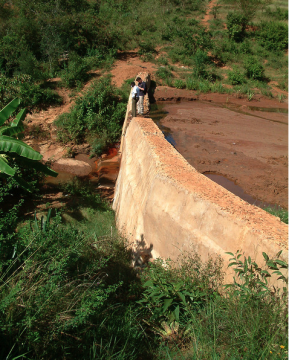Constructing Sand Dams for Water Capture and Storage


Photo: Excellent Development
Drought is the most serious natural hazard facing Eastern Africa in terms of seaverity and frequency of occurrence. The most seriously affected areas are Arid and Semi Arid Lands (ASALS) that face frequent reduction of water or moisture to significantly below the normal or expected amount Pastoralists and agro pastoralists who occupy this vast region barely meet basic water requirements.
During the dry periods pastoralists and agro pastoralists get water for themselves and livestock by scooping into the sand beds of the dry streams at upstream sides of ledges cutting across the channel. Water in such sites is usually clean for drinking but quite finite and quickly gets depleted. Sand dams are an artificial enhancement of this traditional practice that puts extra water into these sand beds to recharge and store water for use.
The technical brief linked below was produced by Practical Answers, the technical advice service of Practical Action, and explains the various steps in constructing a sand dam.
(0) Comments
There is no content